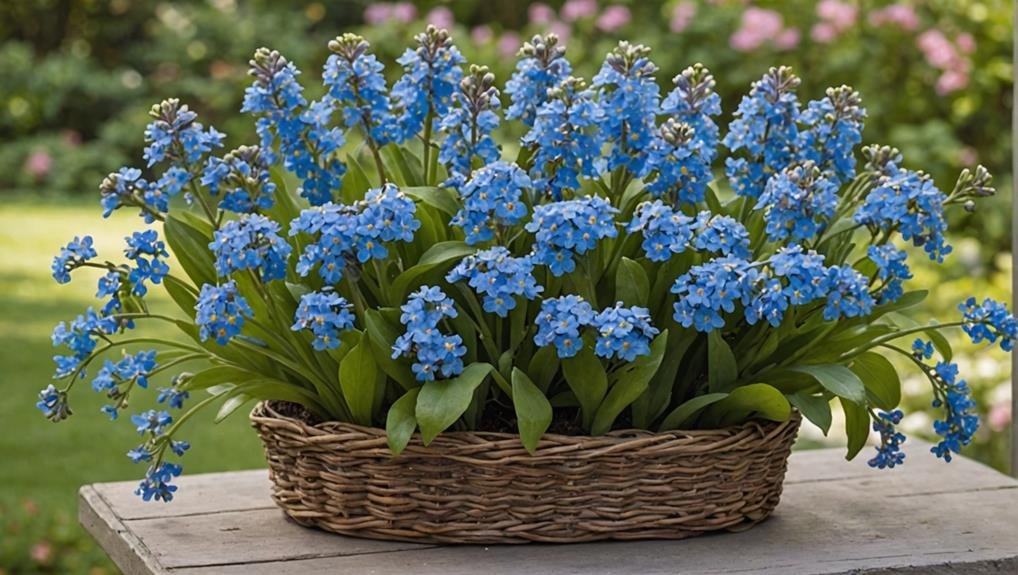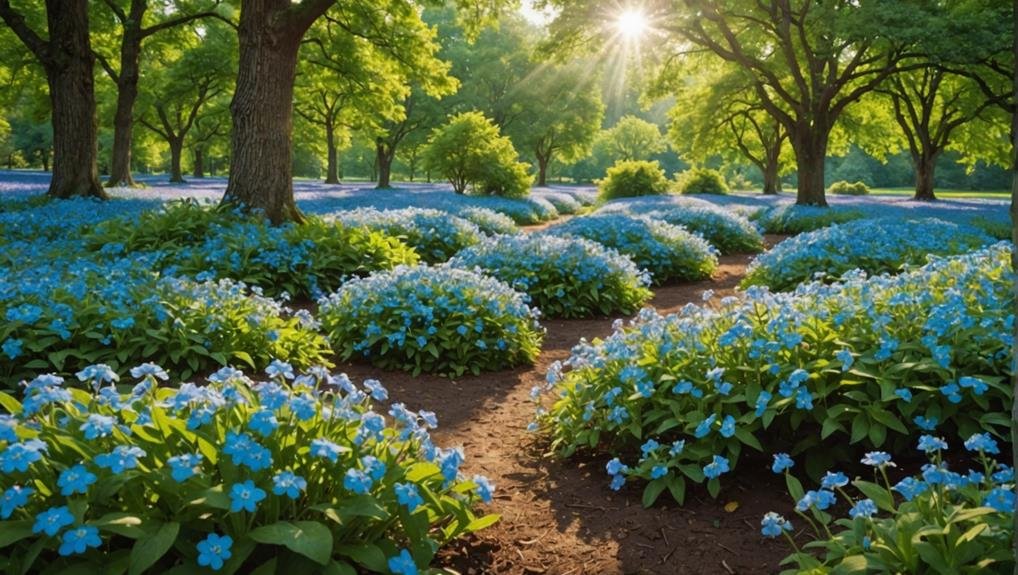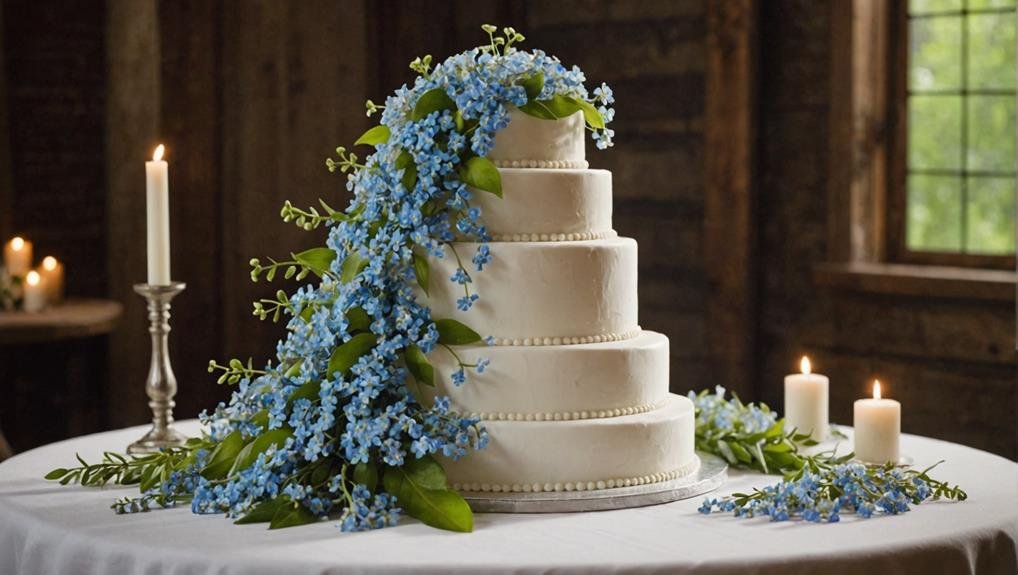In the realm of wedding floral arrangements, the Forget-Me-Not emerges as a poignant symbol of enduring love and loyalty. This modest yet enchanting flower, known scientifically as Myosotis, is celebrated for its delicate blue and white petals that evoke a sense of nostalgia and heartfelt memories. Originating from temperate regions, the Forget-Me-Not thrives in moist, shaded environments, making it a versatile addition to any wedding bouquet or centerpiece. To understand how this flower can elevate the emotional resonance of your special day, we will explore its various attributes, cultural significance, and practical applications in wedding decor.
Flower Overview

Forget-me-nots are small, delicate blue flowers with a yellow center, symbolizing true love, faithfulness, and enduring connections. These sentimental blooms are a popular choice for weddings, often included in various floral arrangements to enhance the emotional resonance of the occasion.
The symbolic meanings associated with forget-me-nots make them particularly suitable for events where loyalty and everlasting love are celebrated.
Incorporating forget-me-nots into wedding floral arrangements can evoke a sense of nostalgia and heartfelt memories. Their versatility allows them to blend seamlessly with a wide array of color schemes and other flower types, ensuring a harmonious and cohesive look.
Whether used in bouquets, boutonnieres, or centerpieces, forget-me-nots add a touch of sentimentality and elegance to any wedding setting.
The flowers' delicate nature and meaningful symbolism make them an ideal choice for couples looking to infuse their special day with deeper emotional significance. By including forget-me-nots in your wedding floral themes, you not only enhance the aesthetic appeal but also reinforce the themes of unity, loyalty, and enduring love, creating a memorable and touching atmosphere for all attendees.
Physical Description
Characterized by their small size and delicate structure, these flowers exhibit five petals in shades of blue and white, often forming clusters on slender stems. The dainty, bright appearance of forget-me-nots makes them a charming addition to any wedding ensemble. Their symbolic meanings of true love and cherished memories add an emotional depth to floral arrangements, making them particularly suitable for romantic events like weddings.
Forget-me-nots are frequently incorporated into bouquets, corsages, and boutonnieres, where they contribute a whimsical charm. Their versatility allows them to pair well with a variety of other blooms, enhancing both the aesthetic appeal and sentimental value of the arrangements. For those interested in DIY projects, forget-me-nots are relatively easy to handle and can be used to create personalized floral designs that capture the essence of the occasion.
When it comes to care tips, forget-me-nots thrive in well-watered environments and prefer partial shade, making them ideal for outdoor weddings or shaded indoor arrangements. Ensuring they receive adequate moisture will maintain their delicate beauty throughout the event. Overall, their combination of visual appeal and symbolic significance makes forget-me-nots a meaningful choice for wedding florals.
Available Colour Varieties

In wedding florals, the available color varieties of forget-me-nots primarily include shades of blue, white, and occasionally pink, allowing for versatile and elegant arrangements. These color options provide a broad palette to match various wedding themes, whether aiming for a classic, rustic, or modern aesthetic.
The iconic blue forget-me-nots are often chosen for their unique color symbolism, representing true love, loyalty, and remembrance. White forget-me-nots, on the other hand, evoke purity and innocence, making them a popular choice for brides seeking a traditional look. The rare pink variety adds a soft, romantic touch, appealing to those with more whimsical bridal preferences.
Incorporating forget-me-nots into floral arrangements can enhance the overall visual appeal and coherence of the wedding decor. For instance, pairing blue forget-me-nots with white and ivory roses creates a sophisticated mix that complements a wide range of color schemes. This combination not only underscores the elegance and charm of the event but also aligns with the symbolic meanings of the flowers.
Ultimately, the color choices available for forget-me-nots offer brides the flexibility to customize their bouquets, ensuring their wedding flowers resonate with personal tastes and the chosen wedding theme.
Latin Name and Taxonomy
Myosotis, commonly known as forget-me-nots, derives its name from the Greek words meaning 'mouse' and 'ear,' a nod to the shape of its leaves. These delicate flowers belong to the Boraginaceae family, which also includes well-known plants like borage and heliotrope. The genus Myosotis comprises about 50 species, with Myosotis scorpioides and Myosotis sylvatica being the most prevalent.
In terms of botanical characteristics, forget-me-nots are easily recognized by their small, vibrant blue blossoms with yellow centers. This unique coloration has contributed to their symbolic meanings, representing true love, remembrance, and fidelity in the language of flowers. These attributes make them a poignant choice for weddings and other ceremonies that emphasize enduring emotional bonds.
From an evolutionary history perspective, forget-me-nots have adapted to a variety of climates and conditions, which has allowed them to naturalize in many regions beyond their native Europe and Asia, including North America. Their ability to thrive in diverse environments speaks to their resilience and versatility.
Cultural connections to forget-me-nots are rich and varied. These flowers have been celebrated in folklore, literature, and art, further solidifying their place as symbols of enduring affection and memory.
Geographical Origins

Although forget-me-nots are native to Europe and Asia, they have successfully established themselves in various regions around the globe. These charming flowers, scientifically known as Myosotis, thrive in damp, shady environments such as woodlands, meadows, and riverbanks. Their global distribution can be attributed to their adaptability and the symbolic meanings they carry, which include remembrance, true love, and lasting connections. Such meanings make them a favored choice for weddings and special occasions worldwide.
The spread of forget-me-nots is not limited to their native regions. They have been introduced and naturalized in North America, Australia, and New Zealand, among other places. This wide geographical distribution has allowed people from different cultures to appreciate their delicate beauty and profound symbolism.
| Region | Native/Introduced | Common Habitats |
|---|---|---|
| Europe | Indigenous | Woodlands, Meadows |
| Asia | Indigenous | Riverbanks, Shady Areas |
| North America | Introduced | Gardens, Parks |
| Australia | Introduced | Urban Green Spaces |
| New Zealand | Introduced | Waterways, Forests |
The ability of forget-me-nots to adapt to various climates and environments has secured their presence in many parts of the world, enriching the floral diversity and adding to their global significance.
Season Availability
Forget-me-not flowers are mainly available during the spring and early summer months. These delicate blooms thrive in cooler temperatures, lending themselves perfectly to the season's floral arrangements. Known for their vibrant blue petals and contrasting yellow centers, forget-me-nots are particularly cherished for their unique aesthetic appeal in wedding bouquets.
The availability of forget-me-nots can vary based on regional and local climate conditions. In general, they flourish in gardens and wildflower meadows where the temperature is moderate, making them a seasonal delight that many brides seek for their nuptial celebrations. The forget me not symbolism, often associated with love and remembrance, makes these flowers a poignant choice for wedding ceremonies.
When considering forget me not bouquet ideas, leveraging their natural beauty and meaning is crucial. Brides can incorporate them into mixed floral arrangements for a touch of charm and nostalgia or opt for an exclusive forget-me-not bouquet for a more understated, yet elegant look.
Their availability during the spring and early summer makes them an ideal choice for weddings held during these months, ensuring that their symbolic presence can be beautifully showcased.
Growing Conditions

Ideal growing conditions for forget-me-nots include damp, well-drained soil and partial shade, making them perfect for woodland gardens or shaded areas. These delicate blue flowers prefer cooler temperatures and can endure light frost, making them suitable for both spring and fall planting. When planting forget-me-nots, make sure the soil has a slightly acidic to neutral pH level, ideally between 6.0 and 7.0, to promote peak growth.
Watering tips for forget-me-nots involve keeping the soil consistently damp but not waterlogged. Regular watering is essential, especially during dry periods, to maintain the plant's health. A balanced fertilizing schedule, applied once a month during the growing season, can support strong growth and abundant flowering. Use a balanced, water-soluble fertilizer to provide the necessary nutrients.
Forget-me-nots are relatively low-maintenance but can be vulnerable to certain pests and diseases. Common issues include aphids, slugs, and powdery mildew. Regular monitoring and early intervention with appropriate treatments can prevent these issues from escalating. Removing spent blooms will not only prolong the flowering period but also help control the spread of the plant in your garden.
Cultural Significance
Steeped in rich cultural symbolism, forget-me-nots embody themes of remembrance, eternal love, and fidelity across various traditions. These delicate blue flowers have long held significant symbolic meanings, resonating deeply with sentiments of loyalty and undying affection.
Historical traditions often highlight their poignant associations; for instance, in German folklore, there is a tale of a knight who, while gathering these blooms for his beloved, tragically fell into a river. As he sank, he threw the flowers to his love, crying out, 'Forget me not.'
Such narratives have cemented the forget-me-not's place in cultural consciousness as a powerful emblem of true love and devotion. Beyond folklore, these flowers carry a broader sentimental value, frequently serving as tokens of remembrance for loved ones who have passed away. Their inclusion in various cultural ceremonies underscores their role in expressing deep, enduring affection and loyalty.
The small, unassuming flowers are therefore more than mere botanical specimens; they are vessels of profound emotional and cultural significance. Their symbolic meanings make them cherished elements in a variety of rituals and celebrations, where they continue to convey messages of steadfast love and unwavering fidelity.
Typical Use in Weddings

Given their rich cultural significance, forget-me-nots find a cherished place in wedding ceremonies, symbolizing true love, faithfulness, and lasting memories. These delicate flowers are often incorporated into bridal bouquets, boutonnieres, corsages, and various floral arrangements, adding a touch of sentimentality and elegance to the occasion. Their petite blue petals and modest size make them an excellent choice for infusing a subtle yet impactful burst of color into wedding florals.
Couples frequently choose forget-me-nots to honor loved ones who have passed away or to underscore the importance of remembering special moments shared with family and friends. Their versatile nature allows them to complement a wide array of wedding themes, from romantic and traditional to whimsical and garden-inspired settings.
The symbolic meanings of forget-me-nots are often highlighted through creative arrangements, such as combining them with other blooms for a unique decor or using them as sentimental touches in centerpieces and aisle decorations. These flowers serve not only as beautiful adornments but also as poignant reminders of the enduring love and special memories that weddings celebrate. Their presence in wedding decor can thusly transform ordinary floral designs into meaningful and memorable elements of the ceremony.
Alternative Flower Types
When considering alternatives to forget-me-nots for wedding florals, options like ivory roses, waxflower buds, and luxury flocked foliage offer unique and elegant choices for bouquets and arrangements.
Ivory roses are a timeless classic, symbolizing purity and elegance, making them an ideal centerpiece for any wedding floral arrangement. Waxflower buds add a touch of whimsy and texture, providing a delicate contrast to the more substantial roses.
Luxury flocked foliage enhances the overall aesthetic with its rich textures and sophisticated appearance, perfect for creating an opulent bouquet inspiration. These elements can be combined to create customized floral arrangements tailored to the bride's vision, ensuring a cohesive theme throughout the wedding.
To elevate the beauty of these alternative flower types, incorporating pearl and crystal strands can add a subtle sparkle, while an ivory ribbon bow ties the bouquet together with a polished finish. Customization options are plentiful, allowing for matching buttonholes, corsages, and even cake toppers that align with the chosen color scheme.
Additionally, these floral arrangements can be scaled to suit different members of the wedding party, from junior bridesmaids to the bride herself, ensuring a harmonious and elegant presentation for the entire event.
